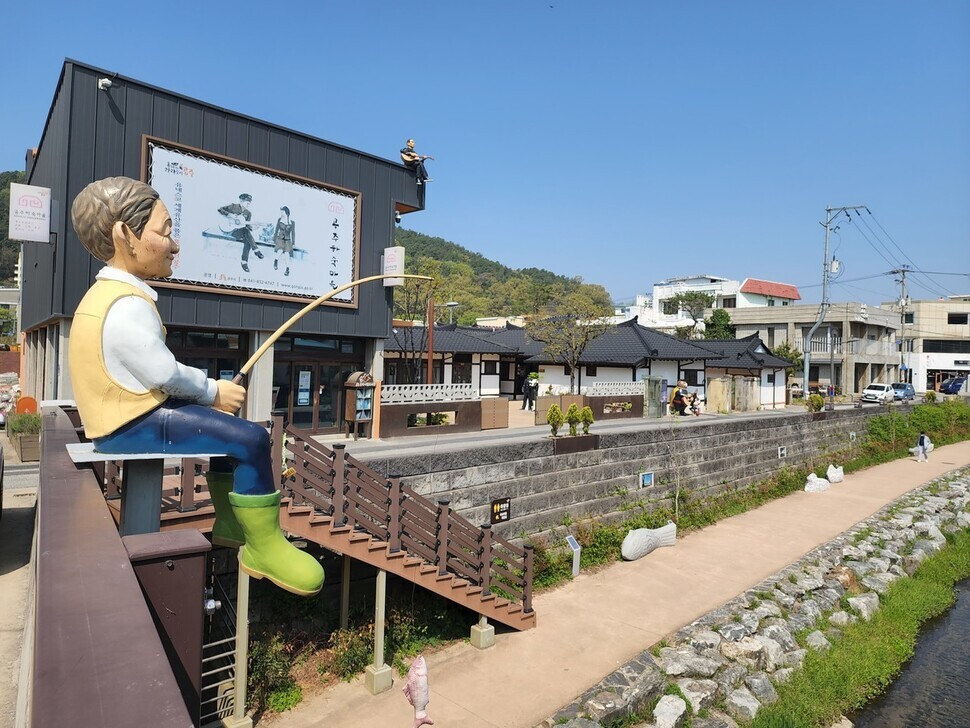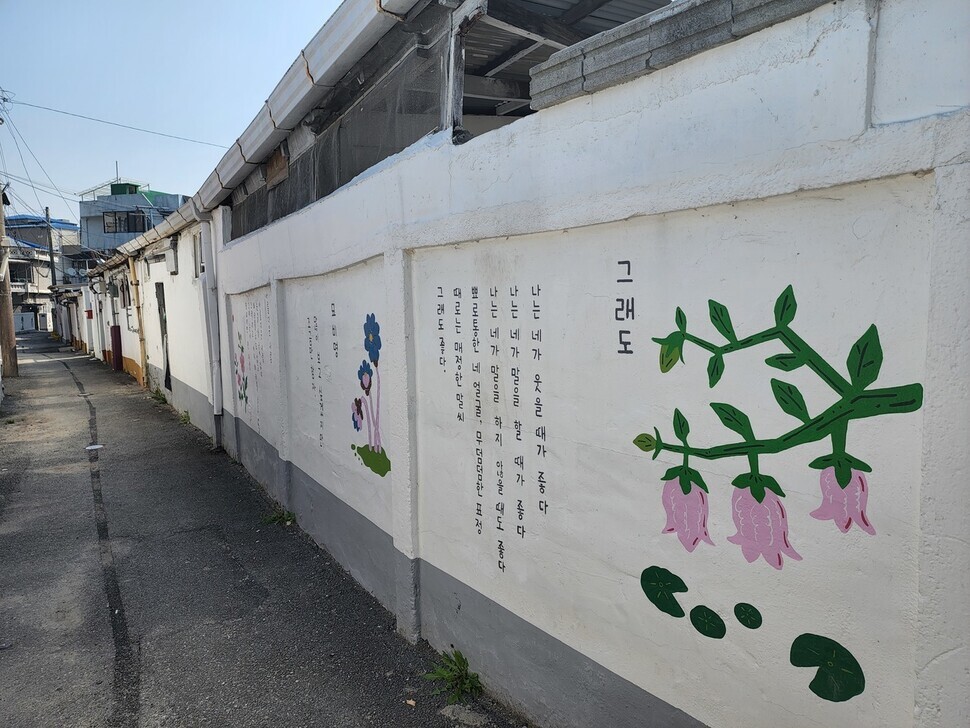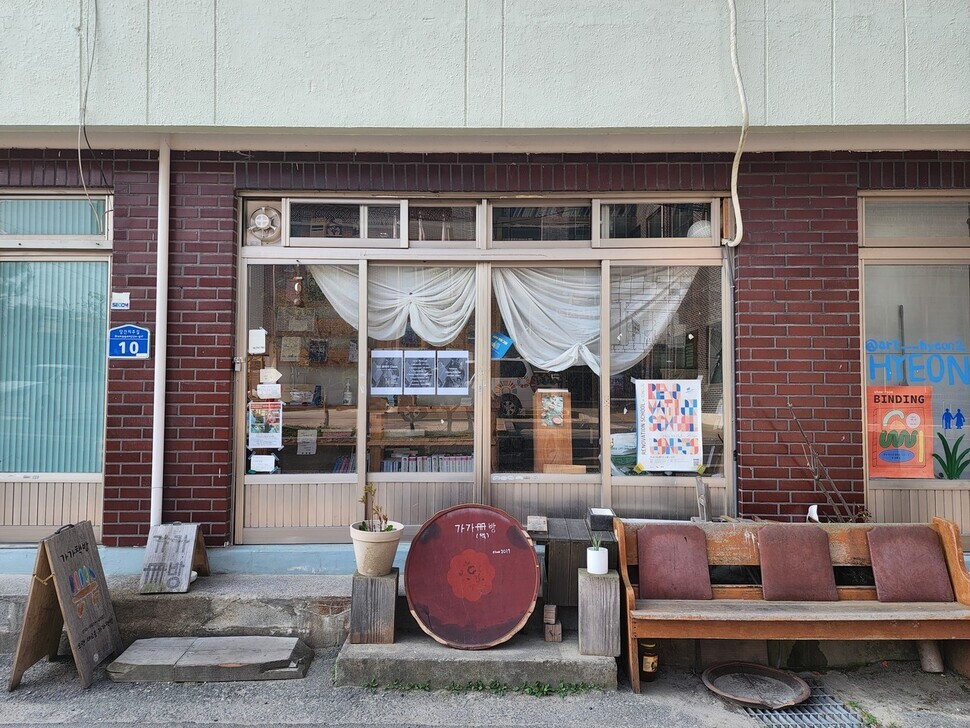hankyoreh
Links to other country sites 다른 나라 사이트 링크
[Korea travels] Take a slow stroll down the nostalgic alleyways of Gongju

“You have to look closely / to see how beautiful it is // You have to look for a long time / to see how lovely it is // That’s how you are too.”
On April 19, I was visiting the so-called Ra Tae-joo Alley in the Banjuk neighborhood of Gongju, South Chungcheong Province. The poet’s poem “Wildflower” was written on a white wall, the dreary cement walls of the alley having been adorned with Ra’s poem and paintings of flowers, bringing it new life.
Going down the narrow path led me to the Daetong Temple Rest Area. An urban cultural heritage park had been erected there, where relics of the Baekje-era temple, such as giwa roof tiles, had been found. Relics from Daetong Temple have been found in 21 locations in the Banjuk neighborhood area, and excavations are still taking place there to this day.
The combined area of the Banjuk, Bonghwang, Jung, and Junghak neighborhoods is the original city center of Gongju. The location of the Chungcheong provincial governor’s office and the South Chungcheong provincial office during the Joseon era and the Japanese colonial period, respectively, the area used to be the administrative center of Chungcheong Province.
But now, the Singwan neighborhood has become the new city center of Gongju, while Gongju’s old town has fallen into decline. It was during the early 2010s that the winds of change blew in Gongju’s lackluster old downtown. Urban regeneration projects upgraded the area’s underdeveloped environment while preserving its original look, leading to the creation of alleyways with distinct themes, such as one dedicated to dragonflies. Recently, the area has been garnering attention among the younger generations as a “newtro” — modern yet retro — travel destination.

There are seven themed alleyways in Gongju’s original city center, from the Ra Tae-joo Alley to Gamyeong Road. The alleyways straddle Jemin Stream, an urban stream around 5 meters wide and 4.2 kilometers long that traverses Gongju’s old downtown area and flows into the Geum River.
The Ra Tae-joo Alley that I visited that day led me directly to Gamyeong Road. The road was named thus because it used to be where the Chungcheong Gamyeong — or the office of the Chungcheong provincial governor during the Joseon era — was located. The location of the Kongju National University Middle School and High School is the old site of the Chungcheong Gamyeong, to be exact. Hanging on the schools’ front gate, which was made of hanok giwa roof tiles, was a sign that read “Chungcheong Gamyeong Government Office Gatehouse.” The gate was a reproduction of the old Gamyeong’s gatehouse and main entrance.
Black-and-white photos hung on trees by the road that led to Daetong Bridge from the schools’ front gate. They were pictures depicting old Gongju’s scenery and people: high schoolers posing in front of Geumgang Bridge in the 1960s, graduation pictures from Gongju’s Geunhwa Kindergarten in 1949, the spot in front of Gongbukru Pavilion where people used to do laundry in the 1950s, and more.
Unlike the Gongju of yore seen in the black-and-white photos, Gamyeong Road was populated by two-story commercial buildings with coffee shops, hair salons and stationery stores. Interestingly enough, each store had on display a black-and-white photo of the store owner. It almost felt as if the store owners in the photos were greeting customers in front of their establishments. Once you stepped inside those stores, the shop owners from the pictures would greet you in real life.
Home to various workshops and galleries, Gamyeong Road is also known as a street for artists. An art museum on Gamyeong Road allows you to admire artworks by local artists free of charge. It’s called Lee Mi-jeong Gallery, located inside a building that used to house a bookstore called Munhwadang in the 1960s. Each month, local artists exhibit their work at the museum.
Gaga Shop, which sells souvenirs made by local artists, is also located on Gamyeong Road. Its owner, Seo Dong-min, first visited the old town of Gongju in 2018 and fell in love with the area’s charm, ultimately becoming a Gongju resident. He also owns an unmanned bookstore called Gaga Bookstore nearby. He said, “I visited Gongju while I was experiencing burnout from work, and it felt as if time passed slowly here. More than anything, I loved the quiet and comfort of Gongju.”
He believes the appeal of Gongju’s old town is in its alleyways. “If you walk along Jemin Stream, you’ll find access roads into alleyways every once in a while. It’s nice to just walk down alleyways you want to explore spontaneously. You’ll be able to feel the charm of old alleys,” he said.

Walking towards Jemin Stream from Gamyeong Road will lead you to a nostalgic road inspired by the boarding houses that lined it in the 1970s. The alley is decorated by murals of students wearing 1970s school uniforms. There used to be many boarding houses in Gongju’s old town, as lots of schools including Gongju National University of Education and Kongju National University High School are clustered together in the area.
“During the 1970s and ’80s, one house out of two from near Kongju National University High School to Jemin Stream used to be boarding houses,” explained Baek Sun-jeong, a culture and tour guide for Gongju city. “As the number of students dwindled, boarding houses disappeared, so the boarding house village road was formed to evoke that time period.”
Now, instead of boarding houses, guesthouses and hanok cafes, workshops, and galleries are opening up to cater to tourists visiting the area.
Many historical vestiges remain in Gongju’s old city center as well. A number of modern cultural heritages are located near Jemin Stream, from Jungdong Cathedral, the first Catholic church in the Gongju area that was built in 1897; to old missionary residences; Gongju Jeil Church, which was built in the 1900s; Gongju Pulkkot Literary House, which is housed in a Japanese-style house that was constructed during the Japanese colonial period; and the former Gongju Town Office.
In particular, the former Gongju Town Office, which was built in 1923, is now being used as an exhibition hall that showcases modern architecture. The museum comprises an exhibit that provides an overview of modern architecture’s characteristics and the meaning of architecture and a space where one can get a look at Gongju’s old town and its modern architecture as well as their history.
Crossing the bridge across Jemin Stream from the Ra Tae-joo Alley will take you to the alleyway behind the Jungdong branch of the National Agricultural Cooperative Foundation. Gongju residents call this area “Dragonfly Alley.” Adorned by flower gardens, the street has benches one can sit on and relax while admiring the scenery. A textile factory on the street, which used to be a common sight in bygone times, has been turned into a coffee shop. Hopscotch squares have been drawn on the ground in front of the coffee shop to evoke how children used to play in the alleyways during the 1970s and ’80s.
There’s a cafe called Lucia’s Earth with its prominent shabby blue front gate nestled deep within the alley. The owner of the cafe, Seok Mi-gyeong, opened up the space in 2013 after renovating an old house built in 1963 in a modern style. At the time, the alley had many empty houses, and passers-by were few and far between. Now, the alleyway has become well-known with visitors from all around the country, and around 40 coffee shops have sprung up in the area in the last 10 years.
“A lot of time has accumulated in [Gongju’s] old town. Each alleyway has its own stories to tell. Leisurely strolling along the back streets, you’ll be able to feel the joy of discovering hidden gems,” Seok, an early discoverer of the charm of old alleyways, said.
Past the alley is Hoseo Theater, which opened its doors in 1967. Still preserved on the wall of the theater is the poster painting for an old movie called “Fight in Gongsan” (1968). Though it's currently closed, Hoseo Theater will be transformed into a local culture platform by next year.
Following along the fortress pathFood is an integral part of travel. In Gongju, the historical Sanseong Market, which was formed in 1937, is the perfect place to get a taste of delicious food. Over 700 stores are in business at the market, from rice cake stores to fruit stands and restaurants. Gongu’s best-known regional produce, chestnuts, are made into chestnut mochi and chestnut injeolmi and sold here.
There’s also a five-day market. If you make plans to arrive on one of the market days (days that end in a “1” or “6”), you can see the permanent market along with the other stalls.
Only about a 10-minute walk from Sanseong Market, you can find Gongsan Fortress (Historic Site No. 12), which dates to the Baekje era. Known in Baekje times as “Ungjin Fortress,” Gongsan was an earthen fortress at the time, but was rebuilt in stone during the reign of King Injo of Joseon — the form it survives in to this day. The fortress has been designated as a UNESCO World Heritage site.
The fortress follows along a ridge 110 meters above sea level, with a total length of 2.6 kilometers. It takes between an hour and an hour and a half to walk around the whole structure. While you’re walking, you can take a rest at one of its many pavilions, which are designated as cultural heritage sites — including Geumseo-ru, Jinnam-ru, Ssangsu-jeong, Yeongdong-ru, Gwangbok-ru, and Gongbuk-ru.
There are other interesting sights to see too. Twice a day every Saturday and Sunday through late October, visitors to the fortress can see the “changing of the Ungjin gate guard”: a reenactment of the gate guard that once protected the fortress.
By Her Yun-hee, staff reporter
Please direct questions or comments to [english@hani.co.kr]

Editorial・opinion
![[Editorial] Intensifying US-China rivalry means Seoul must address uncertainty with Beijing sooner than later [Editorial] Intensifying US-China rivalry means Seoul must address uncertainty with Beijing sooner than later](https://flexible.img.hani.co.kr/flexible/normal/500/300/imgdb/original/2024/0517/8117159322045222.jpg) [Editorial] Intensifying US-China rivalry means Seoul must address uncertainty with Beijing sooner than later
[Editorial] Intensifying US-China rivalry means Seoul must address uncertainty with Beijing sooner than later![[Column] When ‘fairness’ means hate and violence [Column] When ‘fairness’ means hate and violence](https://flexible.img.hani.co.kr/flexible/normal/500/300/imgdb/original/2024/0516/7417158465908824.jpg) [Column] When ‘fairness’ means hate and violence
[Column] When ‘fairness’ means hate and violence- [Editorial] Yoon must stop abusing authority to shield himself from investigation
- [Column] US troop withdrawal from Korea could be the Acheson Line all over
- [Column] How to win back readers who’ve turned to YouTube for news
- [Column] Welcome to the president’s pity party
- [Editorial] Korea must respond firmly to Japan’s attempt to usurp Line
- [Editorial] Transfers of prosecutors investigating Korea’s first lady send chilling message
- [Column] Will Seoul’s ties with Moscow really recover on their own?
- [Column] Samsung’s ‘lost decade’ and Lee Jae-yong’s mismatched chopsticks
Most viewed articles
- 1[Editorial] Transfers of prosecutors investigating Korea’s first lady send chilling message
- 2[Exclusive] Unearthed memo suggests Gwangju Uprising missing may have been cremated
- 3[Column] US troop withdrawal from Korea could be the Acheson Line all over
- 4Xi, Putin ‘oppose acts of military intimidation’ against N. Korea by US in joint statement
- 5[Column] When ‘fairness’ means hate and violence
- 6‘Shot, stabbed, piled on a truck’: Mystery of missing dead at Gwangju Prison
- 7[Editorial] Intensifying US-China rivalry means Seoul must address uncertainty with Beijing sooner t
- 8Spotlight turns to Hyundai Group Chairwoman’s visit to North Korea
- 9[Column] Samsung’s ‘lost decade’ and Lee Jae-yong’s mismatched chopsticks
- 10[Column] Will Seoul’s ties with Moscow really recover on their own?